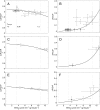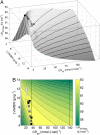Experimentally observed phenomena on cardiac energetics in heart failure emerge from simulations of cardiac metabolism
- PMID: 19357309
- PMCID: PMC2667147
- DOI: 10.1073/pnas.0812768106
Experimentally observed phenomena on cardiac energetics in heart failure emerge from simulations of cardiac metabolism
Abstract
The failing heart is hypothesized to suffer from energy supply inadequate for supporting normal cardiac function. We analyzed data from a canine left ventricular hypertrophy model to determine how the energy state evolves because of changes in key metabolic pools. Our findings--confirmed by in vivo (31)P-magnetic resonance spectroscopy--indicate that the transition between the clinically observed early compensatory phase and heart failure and the critical point at which the transition occurs are emergent properties of cardiac energy metabolism. Specifically, analysis reveals a phenomenon in which low and moderate reductions in metabolite pools have no major negative impact on oxidative capacity, whereas reductions beyond a critical tipping point lead to a severely compromised energy state. The transition point corresponds to reductions in the total adenine nucleotide pool (TAN) of approximately 30%, corresponding to the reduction observed in humans in heart failure [Ingwall JS, Weiss RG (2004) Is the failing heart energy starved? On using chemical energy to support cardiac function. Circ Res 95(2):135-145]. At given values of TAN and the total exchangeable phosphate pool during hypertrophic remodeling, the creatine pool attains a value that is associated with optimal ATP hydrolysis potential. Thus, both increases and decreases to the creatine pool are predicted to result in diminished energetic state unless accompanied by appropriate simultaneous changes in the other pools.
Conflict of interest statement
The authors declare no conflict of interest.
Figures




References
-
- Balaban RS. Regulation of oxidative phosphorylation in the mammalian cell. Am J Physiol. 1990;258(3 Pt 1):C377–C389. - PubMed
-
- Ingwall JS, Weiss RG. Is the failing heart energy starved? On using chemical energy to support cardiac function. Circ Res. 2004;95:135–145. - PubMed
-
- Neubauer S. The failing heart—an engine out of fuel. N Engl J Med. 2007;356:1140–1151. - PubMed
Publication types
MeSH terms
Grants and funding
LinkOut - more resources
Full Text Sources
Other Literature Sources
Medical

